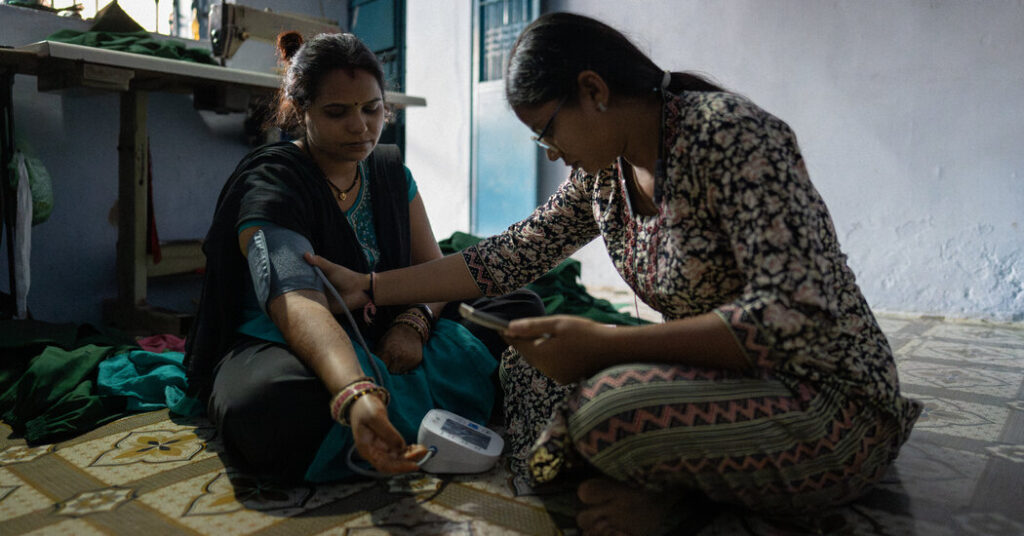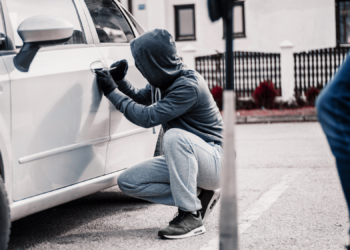Every summer morning, Kantaben Kishen Parmar, a 45-year-old vegetable seller in the Indian city of Ahmedabad, settles onto a patch of ground the size of a large rug, sandwiched between the warming asphalt and a simmering sky, to sell peppers and tomatoes. She doesn’t get back home until 10 p.m.
Over the decades, summers have gotten longer and hotter — average temperatures can hover around 105 degrees Fahrenheit, or 40 Celsius, between March and June — but Ms. Parmar’s hours have remained the same. The toll on her health is growing.
Three years ago, she collapsed during an especially scorching April day and was rushed to a hospital, where she was treated for severe dehydration. Ms. Parmar, who is diabetic, has suffered from urinary tract infections, dizzy spells and heavy bleeding during her period, conditions that medical experts often attribute to heat stress.
“It’s hot from above, it’s hot from the pavement,” said Ms. Parmar as she deftly tossed green peppers onto a weighing scale with her right hand, which bears the tattoo of a heart pierced by an arrow encasing the letters “KK.” The other “K” stands for Kishen, her husband and partner in the business.
“Where are we poor folks going to go?” Ms. Parmar said. “We have no option but to sit here.”
More than a billion Indians face heat waves every year. Hundreds of millions of them work in the informal sector, toiling outdoors or doing piecework in a stifling factory, and are especially at risk as intense bouts of scorching weather become more frequent and higher temperatures stick around for longer.
The Indian government has started campaigns to raise public awareness, urging people to alter their work hours to escape the worst of the heat, drink plenty of water and electrolytes, seek shade and take frequent breaks. Cities and districts have adopted heat action plans to deal with heat waves.
But a far more threatening future looms, scientists and public health experts say: Prolonged exposure to hot weather, especially when combined with humidity, can hinder the ability of people to lead healthy, safe and productive lives. The physiological stress can lead to chronic illnesses and increase people’s chances of dying.
“That is much more of a public emergency than a heat wave,” said Satchit Balsari, an associate professor of emergency medicine at Harvard Medical School. “In mission mode, you can take care of people,” he said, referring to the specific goals of heat action plans. But studying morbidity — how the quality of life can deteriorate under extreme heat — is essential to avert a long-term crisis, he said.
Adapting to climate change by addressing livelihoods, built environments and societies, and making them more resilient, is a central theme at COP 30, the ongoing U.N. Climate Change Conference in Belém, Brazil. In late October, Bill Gates shifted his stance on climate change, writing in a memo that rather than focus on reducing emissions, it would make more sense to put resources into improving the welfare of people facing the harshest effects of climate change.
Grasping India’s Challenges
The summer of 2024 was India’s hottest on record. This year, a heat wave enveloped parts of the country in April, surprising people with its early arrival and intensity. Temperatures hovered around 120 degrees in some places.
Highly developed countries like Japan have instituted new labor laws requiring employers to introduce cooling measures when temperatures cross a certain threshold. But India, which faces a much bigger challenge, has been slower to react.
Public health experts estimate that many more people die of heat-related causes in India than are reported by government agencies. While deaths can be recorded as heat-related when the causes are immediately identifiable, such as a heat stroke or a cardiac arrest on a very hot day, overworked doctors are not sufficiently trained to look for longer-term effects of heat stress.
“It’s like an iceberg,” said Dileep Mavalankar, head of the Indian Institute of Public Health Gandhinagar. “What you see is one-10th of the problem.”
Researchers have urged India to build a single database and uniform standards to determine what constitutes a heat-related death, and to develop plans to adapt to hotter and longer summers. Many also say it is necessary to incorporate more granular data so that people who work in hotter parts of a city — a tightly packed neighborhood or business district, for example — have information specific to them and can take precautions accordingly.
Capturing the impact of heat in a highly unequal society like India’s is the real challenge, Dr. Balsari said. “The street vendor’s experience is very different from the air-conditioned sari shop just behind her.”
Women Bear the Brunt
More than 90 percent of working women in India are in the informal sector. Some can lose as much as 60 percent of their income during the brutal summer months because their working hours are reduced by almost half, or they have to abandon their work, said Reema Nanavaty, who heads the Self-Employed Women’s Association, a labor union with more than 3 million members.
A day’s lost wages could mean one less meal — or no meal — that day, with cascading consequences, Ms. Nanavaty said. A worker might have to borrow money at high rates, or be unable to pay her rent. “Or they can’t afford to pay electricity bills, so when you really need fans for cooling down, your electricity supply is gone,” she said.
Hansaben Veijay Aahir, a waste collector, has become the primary breadwinner in her family of five since her husband lost his factory job. Ms. Aahir, 50, usually sets out from her house at 5:30 a.m., looking for discarded plastic bottles, newspapers and other flotsam that gets dumped overnight on the streets of Ahmedabad, one of India’s largest cities.
Because it can take her hours to find enough trash to sort and sell, she tried minimizing her heat exposure by starting before dawn. “But it’s hard to find trash in the dark and stray dogs have attacked,” she said.
Summers have gotten so much worse in the past five years that Ms. Aahir said she ends up losing a week’s worth of work each month because of dehydration and vomiting. Her already unstable income — she makes 200 rupees (just over $2) on a good day — dries up.
“If I earn daily, I eat daily, but if I miss a day’s work then I have to borrow money,” said Ms. Aahir, one of roughly 36,000 garbage collectors SEWA works with. She borrows from the association rather than go to moneylenders, who charge high interest rates.
Ms. Parmar, the vegetable vendor, also said her monthly income falls, to 10,000 rupees from 15,000 rupees, during summer. Asphalt road surface temperatures can reach 140 degrees or more in extreme heat. “Both me and my vegetables suffer,” she said.
Like many outdoor women workers, she has gotten U.T.I.s, which occur when dehydration along with undergarments and synthetic clothing that traps heat, allow bacteria to thrive. Ms. Parmar said she now uses a low wooden stool to avoid direct heat from the asphalt and wears cotton when she can.
Women in both rural and urban settings tend to hold their urine or drink less water when they are working because they lose less work time by minimizing bathroom breaks. Also, public facilities are not always accessible. Ms. Parmar said the toilet closest to her is about a half mile away, so she doesn’t go often.
No Respite Indoors
Since 2024, researchers at Harvard have been following the lives of nearly 300 informal women workers, mainly in Ahmedabad. The women agreed to wear Fitbits for the duration of the study, being conducted with SEWA, and have heat sensors installed in their homes. The Fitbits, along with smartphones given to the participants, track heart rates, sleep patterns and other data.
A counterintuitive finding was that between 6 p.m. and 10 a.m., when homes are expected to cool down, they are hotter than the outdoors. That creates a vicious cycle of poor sleep compounding fatigue for people laboring in very hot weather for months.
In September, Lucy Siers, a labor rights researcher at the Stern Center for Business and Human Rights at New York University, visited nine garment factories across India that employed nearly 9,000 workers to study their working conditions. Ms. Siers found that hot conditions can be amplified in indoor manufacturing facilities because of such things as poor ventilation, heat-emitting machinery like dryers or irons, or workers packed too tightly on a factory floor.
“It’s a common misconception that indoor workers are protected from exposure to extreme stress because of heat,” Ms. Siers said.
Manufacturers are aware of the toll on their workers, but some are loath to make even basic fixes like adding natural ventilation, Ms. Siers said. Open windows could mean that dust and other debris could attach to the glue used to to fuse fabrics, slowing the process.
Global fashion brands that buy the garments are not thinking about the impact of extreme heat on workers and whether supply chain modifications are required, Ms. Siers said. “It’s complete lack of awareness.”
‘You Have to Learn’
In Sirkharia, a village in Bihar — one of India’s hottest and poorest states — many people dread the onslaught of summer. Average temperatures in the region have inched upward in the last four decades, according to a recent study.
Lalita Devi, 60, said there have been more instances of fainting, dizziness and fatigue in the community starting around a decade ago, usually when people were out tending to their crops.
“The ground water becomes hot, and for that reason, I don’t want to go the fields,” Ms. Devi said.
With their husbands away in search of work, many women are left to juggle farming, cooking for extended families and raising children.
Meena Kumari, a 28-year-old mother of four, said she finds herself yelling at the ceiling fan on hot nights. They bring some respite, but “after a point it doesn’t matter,” Ms. Kumari said. “The fan is just circulating hot air.”
Mohammad Sadullah, who works for the Rural Development Trust, a nonprofit that works with more than 5,000 households in the area, said there are long stretches during summer when the daytime temperature is at least 104 degrees. But initially, many farm workers did not understand the concept of dehydration or that it was linked to their dizzy spells and fatigue.
After he explained that it was essential to drink water, more women now carry plastic bottles of water to work, wrapping them in cloth and tucking them in the shade of plants. The farm workers also learned to make electrolytes using a mixture of water, sugar, salt, lemon and “muri,” or puffed rice, a cheap source of carbohydrates.
“The weather isn’t going to understand that you need to rehydrate,” Mr. Sadullah said he tells them. “So you have to learn.”
Anupreeta Das covers India and South Asia for The Times. She is based in New Delhi.
The post What’s More Dangerous than India’s Frequent Heat Waves? Heat Stress. appeared first on New York Times.




